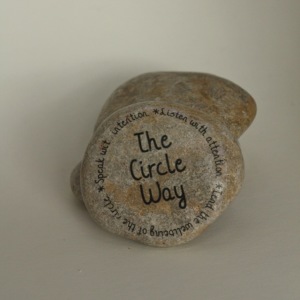 Not long ago, I taught a storytelling workshop in a corporate environment. As is the case with almost all of my workshops, we gathered the participants in circle and started by passing the talking piece and inviting each person to share one personal story. Since much of the work this organization is involved in is conservation-related, I asked them to share a story about something they enjoyed doing outdoors – either as a child or as an adult.
Not long ago, I taught a storytelling workshop in a corporate environment. As is the case with almost all of my workshops, we gathered the participants in circle and started by passing the talking piece and inviting each person to share one personal story. Since much of the work this organization is involved in is conservation-related, I asked them to share a story about something they enjoyed doing outdoors – either as a child or as an adult.
When the talking piece (a simple stone with the organization’s logo on it) had almost completed the circle, one of the last people to hold it said “Is this talking piece magic or something? I now know more about the people in this circle than I’ve known in all the years I’ve worked here!”
When the stone came around to me, I spoke to his comment. “No, it’s not magic in and of itself. It’s just an ordinary stone.” I said. “What IS magic, though, is the way that the talking piece invites us to listen in ways we don’t normally listen and speak in ways we don’t normally speak.”
When a talking piece goes around the circle, only the person holding it speaks. Everyone else is silent and attentive. Even though you may be tempted to interject – to offer advice, another version of the story, or your own story to top what’s been said – you must wait until the stone circles around to you before you can speak. By then, your need to interject into someone else’s story is usually silenced and you speak instead from your own story.
What results is a space where each story is heard in its entirety without crosstalk, correction, or advice.
That’s a powerful notion. It doesn’t happen often in our day-to-day conversations. Pay attention the next time you are chatting with your friend, partner, child, or parent. Do you listen to their WHOLE story without interrupting? Do you let them share sad moments without rushing to fix them? Do you honour their story with attentive listening?
Brene Brown teaches that our need to fix other people is our own “defense against vulnerability”. In other words, when you share something hard with me and I am quick to offer advice on how to resolve that hard thing, I’m doing so because I don’t want to be vulnerable, I don’t want to enter into that hard place with you, and I don’t want to admit that I don’t have all the answers.
Peter Block went even further in a talk I heard him give a few years ago. “Helping is an act of violence,” he said, and then went on to explain that our efforts to help other people are often unwelcome attempts to change or fix something they haven’t given us permission to change. By fixing a problem we haven’t been invited to fix, we are violating that person. Instead we must learn to sit with them in the problem while they work to find their way through.
“Speak with intention. Listen with attention.” That’s what The Circle Way teaches us. It doesn’t say “listen in order to fix” or “listen only until you have a chance to interject” or “speak with the purpose of outshining everyone”.
When I sit in a circle with a dozen other people, I need to be prepared to listen 12 times as much as I talk – even when I’m the teacher. And when I am listening, I need to do so in attentive silence, holding their story as sacred and valuable rather than as something that needs fixing.
The more I practice The Circle Way in my work, the more it is influencing the way I interact with people in my life. I don’t get it right all the time (just ask my daughters or husband!), but I’m a work in progress.
If you want to bring the circle into your own life, here are a few things to consider:
- The next time someone shares a story with you, whether in person or on Facebook, honour their story with intentional listening. Pretend they’re holding a talking piece and wait your turn.
- Do not offer advice unless it’s been specifically requested.
- Do not try to smooth over someone’s grief or pain with platitudes about how it will get better. Just be present in the moment with them.
- When you gather with friends or family, try passing a talking piece (anything can be used – I’ve used pens, leaves, sticks, and even a small statue in the spur of the moment) so that each person’s story can be heard.
Want to know more about The Circle Way? Ask me! I’m part of an international network involved in this work, and would be happy to talk about upcoming workshops that I and/or my colleagues are offering.
